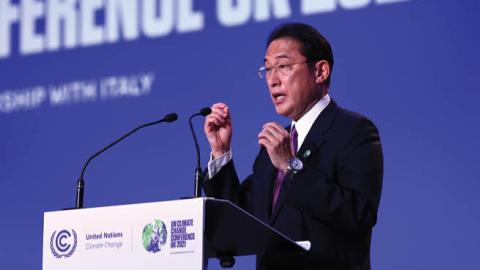With the election over, it is now both the best of times and the worst of times for Prime Minister Kishida and the security challenges facing Japan.
To start with the latter, one only needs to look at the annual white paper, The Defense of Japan 2021 In his preface, Minister of Defense Nobuo Kishi writes that “various security challenges and destabilizing factors have become more tangible and more acute” with the international rules-based order being “greatly tested.”
China’s Aggressive Behavior
In Northeast Asia, China’s military modernization has continued unabated, with its expanding nuclear force and recently reported hypersonic missile test in August.
In the waters surrounding Japan, China has continued, even intensified its unilateral efforts to challenge the status quo in the East China Sea and Japan’s sovereignty over the Senkaku islands. The Ministry of Defense recorded 1,097 Chinese ships operating for 282 days in Japan’s contiguous zone in 2019. In 2020 the number of Chinese ships increased to 1,181 operating for 333 days in Japan’s contiguous zone. In 2019 and again in 2020, Chinese Coast Guard ships entered Japan’s sovereign waters 59 times.
On February 1, 2021 China’s new Coast Guard Law went into effect, allowing the use of weapons in law enforcement operations in China’s claimed “jurisdictional waters,” a concept without standing in international law. In the South China Sea, China continues to disregard the Hague Court ruling against Chinese territorial claims based on historic rights, as it challenges the rules-based international order and the broadly shared vision of a free and open Indo-Pacific.
Over the past year, the PLA has intensified military activities around Taiwan, now recognized in the Defense of Japan 2021 as “important for Japan’s security and the stability of the international community.” PLA bomber swarms around Taiwan have increased in frequency.
From October 1-3, the PLA conducted five major incursions into Taiwan’s airspace. This was followed on October 4 by an incursion of fifty-two aircraft.
On the Korean Peninsula, North Korea has continued the development of its nuclear and missile arsenal in clear violation of United Security Council Resolutions. In March 2021, North Korea tested two new types of ballistic missiles, and, in September, resumed missile tests, capped in October by the apparent submarine launch of a short-range ballistic missile.
Meanwhile, talks aimed at the denuclearization of North Korea have stalled, with Pyongyang continuing to deflect U.S. offers to meet anywhere, any time without preconditions. A day after Pyongyang’s submarine missile launch and following a meeting of senior U.S. and ROK officials, Ambassador Sung Kim reiterated that position.
The Good News
Notwithstanding this challenging security environment, it is also paradoxically, the best of times for Japan’s national security. Prime Minister Kishida inherits a Japan-U.S. alliance at a historic highpoint, thanks in large part to the dedicated efforts of his predecessors, Prime Ministers Shinzo Abe and Yoshihide Suga. Their accomplishments have set Japan’s diplomacy ー and the alliance ー on a firm course going forward.
It is worth briefly recalling the evolution of Japan’s diplomacy and alliance over the past decade. Starting with the concept of Japan as a proactive contributor to international stability and security, Abe directed Japan’s diplomacy and financial resources to advance his vision of a free and open Indo-Pacific, one now shared by the United States, Australia, India, the UK and other European allies.
Abe also moved to strengthen Japan’s alliance with the United States, leading a reinterpretation of Japan’s constitution in 2014 to allow for the limited exercise of collective self-defense, adopting the new Japan-U.S. Defense Guideline in 2015, and consistently increasing Japan’s defense budget – all with the strategic objective of anchoring the U.S. in Asia in Japan. Abe’s work reached its apotheosis at the 2019 meeting of the Security Consultative Committee (SCC) which marked the alignment of U.S. and Japanese security policy documents, including support for a free and open Indo-Pacific.
Prime Minister Suga built on this inheritance. The 2012 SCC committed the alliance to strengthening deterrence and defense capabilities, in particular in the fields space, cyber, and information security, while calling attention to the importance of peace and stability in the Taiwan Strait. Suga also advanced Japan’s commitment to the Quad.
What Comes Next
So, where do Japan and the alliance go from here?
For the Kishida government, it starts with Japan’s National Security Strategy. Issued in December 2013, the now dated document needs to be reviewed in the context of today’s increasingly challenging regional and global security environment and new policy prescriptions developed to protect Japan in the decade ahead.
The LDP campaigned on a defense budget of 2 percent of GDP, and it will be critical for the new government to target that objective.
In the security environment of the mid-to-late 2020s, Japan’s defense needs are many. Given North Korea’s continuing development of its missile arsenal, expanding Japan’s missile defense should be a top priority. In this context and in consideration of strengthening deterrence, serious consideration should be given to developing capabilities that would allow Japan to strike enemy bases to forestall an impending attack. As consideration moves forward, it will be critical to integrate such capabilities into the alliance structure and the Pacific Deterrence Initiative.
At the same time, enhancing Japan’s intelligence collection, satellite capabilities, and information/data processing should likewise be priority areas, linked to rapidly evolving technologies. Future conflicts will be unlike those of the past; developments in the fields of artificial intelligence, space and cyber will be key determinants of success.
The LDP also campaigned on a platform calling for legislation to safeguard Japan’s economic security. At a time when Chinese and North Korean espionage activities are focused on securing access to frontier technologies, Japan must move to strengthen protection of leading-edge technologies now being developed in the private sector in universities and in research institutes. This is critical to Japan’s long-term economic prospects, prosperity and national security.
As for the Japan-U.S. alliance, Prime Minister Kishida has affirmed the strength of the alliance and a shared commitment to working together to realize a free and open Indo-Pacific.
Similarly, Ambassador-designate Rahm Emmanuel, in his testimony before the Senate Foreign Relations Committee cast the alliance as “the cornerstone of peace and prosperity in a free and open Indo-Pacific.”
But challenges are ahead.
Fostering Uncertainty in Beijing
Today, the Biden administration is putting together the 2022 National Defense Strategy with a core conceptual emphasis on Integrated Deterrence. Melissa Dalton, a senior official now acting as the assistant secretary of defense, for strategy, plans and capabilities, explained that “adversaries are pressing for advantage in multiple domains, and our department requires a different approach – one that requires deeper integration with allies…”
To address the expanding security challenges, not only involving the defense of Japan but consideration of various regional contingencies that may potentially affect Japan’s own security, deeper integration will undoubtedly require revisiting the 2015 Defense Guidelines. The 2015 Defense Guidelines were detailed in terms of bilateral cooperation in the defense of Japan but lacked specifics with respect to regional and global cooperation.
A Taiwan contingency is a case in point. Over the past several years, the realization that a Taiwan contingency would inevitably affect Japan’s security has surfaced in political discourse. Deputy Prime Minister Aso commented that a Taiwan contingency “would not be too much to say that it could relate to a survival-threatening situation” for Japan. Prime Minister Kishida stated that Japan would consider “various scenarios” in consultation with the United States.
For both Japan and the United States, Taiwan today presents both a peacetime challenge and a potential wartime challenge.
The peacetime challenge is to enhance deterrence and complicate Beijing’s strategic calculations. The Joint Statements of the March 2021 Two-Plus-Two meeting “underscored the importance of peace and stability in the Taiwan Strait.” The Joint Statement issued at the Biden-Suga Summit spoke to the “importance of deterrence to maintain peace and stability in the region” and reaffirmed the importance of “peace and stability in the Taiwan Strait.”
Diplomacy, by expanding interested parties, can further enhance deterrence, and foster uncertainty in Beijing. The Joint Statement of the 2021 Japan-Australia Two-Plus-Two emphasized the importance of “peace and stability across the Taiwan Strait,” while the Joint Statement of the Japan-UK Two-Plus-Two, while not directly referencing Taiwan, made clear strong “opposition to unilateral attempts to change the status quo and increase tensions” in the South China Sea and East China Sea.
Similarly, the Quad made clear its commitment to a free and open Indo-Pacific, its support for a peaceful resolution of disputes and opposition to coercion. In effect, diplomacy can be marshalled to build a multi-tiered, multi-layered deterrence architecture, one that can foster uncertainty in Beijing.
Becoming Prepared
Simultaneously, the alliance must be prepared to address the failure of deterrence. For Japan, this is both a defense of Japan and an alliance issue.
In any conflict, it is highly unlikely that Japan and U.S bases in Japan will not be targeted by the PLA. Strengthening Japan’s defense capabilities in the southwest islands is an essential starting point in the defense of Japan.
A Taiwan contingency will invariably be an alliance issue, involving the limited exercise of collective self-defense. Going forward, it is important for the allies to develop a clear understanding of what the United States could expect from Japan as well as a clear understanding of what Japan cannot deliver. This is a time-urgent matter.
It is now November 2021. The goblins are gone from Harajuku, but remain in Beijing and Pyongyang, posing growing security challenges to Japan and the alliance.
For over seven decades, the alliance has served as the foundation of regional prosperity, stability and security, and the key to successfully meeting the challenges ahead. Today, drawing on its history, the alliance is well positioned to meet challenges ahead.
Read in Japan Forward















